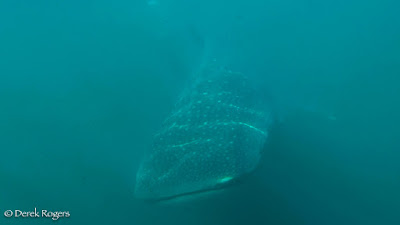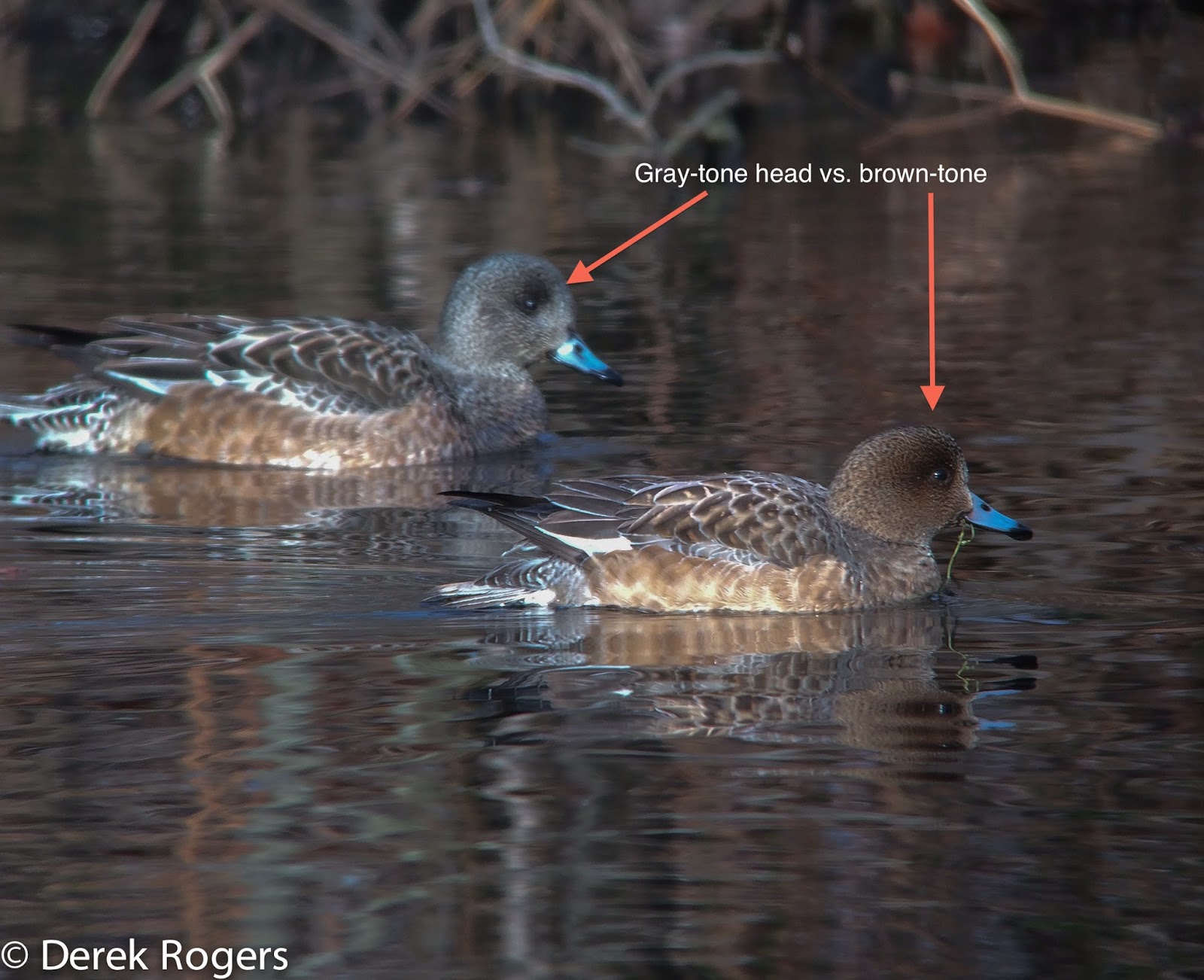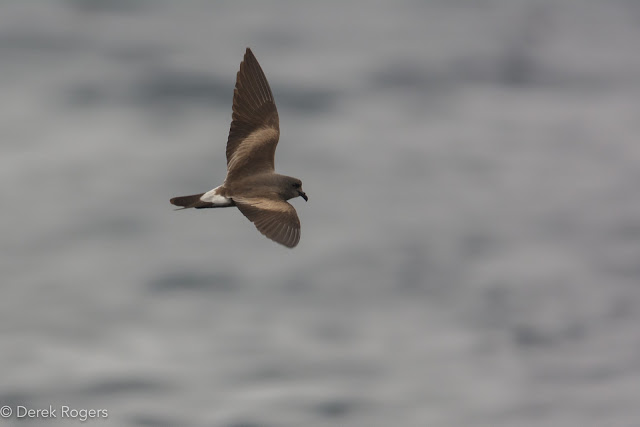 |
| Whale Shark approximately 75 miles southeast of Shinnecok Inlet |
Every day is different. The dynamics of the ocean are part of the lure in venturing out and exploring the deep. Habitats shift and form, along with currents, eddys, upwelling and temperature breaks. You never know what you're going to see and the largely unpredictable nature of the ocean is what truly fascinates me. On 9 August, 2017, Captain John Shemilt, Angus Wilson and I ventured out to sea, heading south-southeast out of Shinnecock Inlet at about 2:00 PM. Sea conditions were extremely calm with 0-5 mph wind out of the north making for a silky ride out to sea. We were headed out towards the Dip (a steep break along the continental shelf) and then south through Ryan and McMaster Canyon where we planned on setting a chum slick out at 500 fathoms (3,000 feet of water). We motored past the Dip and were approaching the top of Ryan Canyon at 4:30 PM when we noticed a gigantic dorsal fin slowly cruising across the surface at 39.869715, -71.752915. We were headed straight towards it and powered the engines down for a closer look. We ran up to the bow and were looking down at a gorgeous Whale Shark! Our sonar screen was marking heaps of bait and it occurred to us that the Whale Shark was feeding, possibly on massive clouds of plankton. The giant fish was extremely cooperative as we slowly repositioned and managed stunning views. We could even make out the remora fish suctioned to the side of the shark. I quickly screwed my GoPro Hero5 onto a long GoPro stick and attempted to get some useful images of the docile beast as it skirted alongside the boat. We were in a 36' Grady and while the shark wasn't quite as big it was pretty darn close. No surprise though as Whale Sharks are the largest fish on planet earth. I uploaded a quick, 7 second video clip to my Vimeo page which can be viewed
here.
 |
| Whale Shark approximately 75 miles southeast of Shinnecock Inlet. Check out the little copepod rocketing down off the left corner of the photo. |
Blown away by the amazing experience, and just slightly behind schedule, we decided to make a run deeper into the canyon to our 500 fathom spot and deploy a menhaden slick. Along the way, we encountered several small groups of Wilson's Storm-Petrels, a single Leach's and a probable Band-rumped that we safely passed off as an Oeanodroma species. Still, this was encouraging for our slick and we began slowly getting a small trickle of storm-petrels. Wilson's were the dominant species but it wasn't long before several Leach's were entering and exiting the area, nabbing pieces of suet and whatever else they could find. Aside from the fatty offerings from our slick, the birds did appear to be feeding on natural prey items as seen in this photograph of Wilson's Storm-Petrel.
 |
| Wilson's Storm-Petrel plucking prey off the silky ocean surface. |
It's hard to say what it might have been feeding on but seems to resemble a copepod of some sort. The near non-existent wind was a handicap in terms of blowing the scent of our chum slick but it made for some excellent study of flight behavior in these particular conditions. It wasn't long before Band-rumped Storm-Petrels began entering the slick and provided us with great views. The Oceanodroma storm-petrels always seem to be a bit more nervous around boats compared the brazen Wilson's. Still, we had a great time viewing them and managed some decent record shots. It's always good to see Band-rumped Storm-Petrels as there is a limited window of opportunity to see this species of storm-petrel compared to the others off Long Island. The water temperature was quite cold for August. We only found 69-71º water throughout our two days at sea and this may be the reason for lower Band-rumped vs. Leach's numbers in our deep water drops. It's usually not uncommon to find water temps close to 80º in August off Long Island. But then again, just as every day is different, so is every year. The Gulf Stream is just really far away this year.
 |
| Leach's Storm-Petrel (top left) swooping in above Wilson's Storm-Petrels approximately 85 miles SSE of Shinnecock Inlet |
 |
| Leach's Storm-Petrel approximately 85 miles SSE of Shinnecock Inlet. Note overall brownish appearance with pale, strongly contrasting carpal bar, notched tail with dark line bisecting white rump patch. |
 |
| Band-rumped Storm-Petrel. Note darker above, not quite as long-winged as Leach's with square tail and U-shaped white rump patch. No leg protrusion as seen in Wilson's and less contrasting carpal bars. |
It was a good first day of our overnight trip. Although we had little time to bird we still pulled in some good birds. Plus a Whale Shark!! We spent most of the next morning working two slicks, one at 500 fathoms and second a bit deeper at 1000 Fathoms (6,000 feet). Storm-Petrel ratios were similar to yesterday evening's numbers with a slight uptick in Leach's and Band-rumped. The Leach's were notably cooperative on 10 August and perhaps they were getting used to our presence as we continually drifted and repositioned up and down the slick. Here a couple of photos from 10 August. Alas, no White-faced Storm-Petrels on this trip, although we had a distant suspect early on just after
sunrise. The lack of Audubon's Shearwaters was a testament to the cold water and distance from the Gulf Stream. There was no sargassum weed to be found out there.
 |
| Leach's Storm-Petrel 95 miles southeast of Shinnecock Inlet |
 |
| Leach's Storm-Petrel 95 miles southeast of Shinnecock Inlet |
 |
| Leach's Storm-Petrel 95 miles southeast of Shinnecock Inlet |
 |
| Band-rumped Storm-Petrel 95 miles southeast of Shinnecock Inlet |
 |
| Band-rumped Storm-Petrel 95 miles southeast of Shinnecock Inlet |
 |
| Band-rumped Storm-Petrel 95 miles southeast of Shinnecock Inlet |
And here are the totals from the trip:
6 Cory's Shearwater
23 Great Shearwater
3 Cory's/Great Shearwater
1 Sooty Shearwater
1 Manx Shearwater
242 Wilson's Storm-Petrel
38 Leach's Storm-Petrel
12 Band-rumped Storm-Petrel
4 Oceanodroma sp.
1 shorebird sp.
1 Larus sp.















Comments
Post a Comment